Many times over the past few years and at least twice since the 2019 baseball season started, I’ve heard comparisons of Los Angeles Angels center fielder Mike Trout to New York Yankees Hall of Famer Mickey Mantle. Now I’ve never been a Yankees fan or a Mantle fanatic so I have no compunction to jumping on board the Trout bandwagon, but my first instinct is to scoff at such a notion. Perhaps it’s the baseball card collector in me that sees Mickey Mantle as an untouchable given he’s the single most coveted post-war subject on cardboard and the primary reason for the almost 70 year reign of Topps, but I also realize that his popularity in the hobby is much larger than his actual accomplishments on the field, because as grand as they obviously were, there are plenty of baseball players with a superior body of work overall. OK, so I’m open to the discussion. I don’t really follow Trout all that much other than to know he’s really good, so as I put this blog together, I’m going in with an open mind and a blank slate; no preconceptions. I’ll learn the ins and outs of this comparison as I write it, and I’ll play the advocate and cross-examiner for both parties. At the end of this, I’ll issue a ruling. Here we go:
Mickey Mantle: A Pinstriped Legend
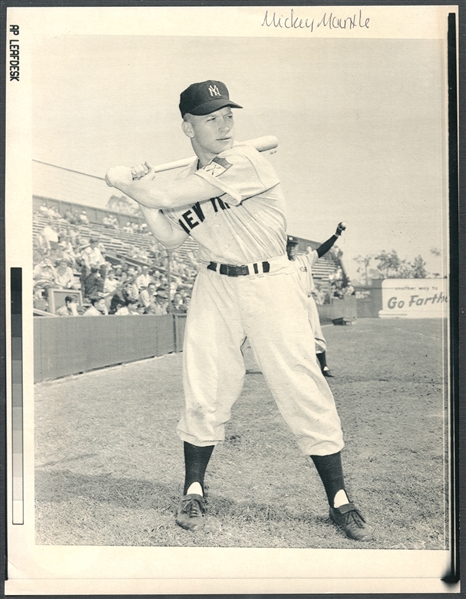 As I said, it’s difficult to entertain a comparison of any modern day ballplayer to Mickey Mantle, and I imagine to the majority of Yankees fans, them’s fightin’ words! He’s so beloved to collectors that anything Mantle related immediately moves to the head of the class. But OK, let’s put that on the back burner and talk accomplishments, and to be fair we’ll toss out the partial stats of his rookie year and stick to the first 7 full seasons of his career, same amount of time Trout has been in the league. While Mantle’s first three seasons were solid, he really didn’t have the breakout year worthy of being named Joe DiMaggio’s heir apparent until 1955, when he led the American league in triples (11), homers (37), walks (113) and slugging percentage (.611). And of course, Mantle has the 1956 Triple Crown season under his belt (52 homers, 130 RBI, .353 batting average and an AL MVP award). I haven’t even looked at Trout’s accomplishments yet but I’m pretty confident he can’t match that. Mantle followed up that season with another AL MVP performance, posting 34 homers and batting .365 while walking a league-leading 146 times for a gaudy .512 on-base percentage, second to Ted Williams in large part due to “Teddy Ballgame’s” .388 batting average (no shame there). In the final year of our seven season comparison, Mantle once again took the home run crown with 42 round-trippers and topped the league with 129 walks while batting .304. In all,, Mantle smacked 234 dingers, batted .319, stole 69 bases, led the league in homers three times, runs scored four times, triples once, RBI once and won an AL batting title and two AL MVP Awards.
As I said, it’s difficult to entertain a comparison of any modern day ballplayer to Mickey Mantle, and I imagine to the majority of Yankees fans, them’s fightin’ words! He’s so beloved to collectors that anything Mantle related immediately moves to the head of the class. But OK, let’s put that on the back burner and talk accomplishments, and to be fair we’ll toss out the partial stats of his rookie year and stick to the first 7 full seasons of his career, same amount of time Trout has been in the league. While Mantle’s first three seasons were solid, he really didn’t have the breakout year worthy of being named Joe DiMaggio’s heir apparent until 1955, when he led the American league in triples (11), homers (37), walks (113) and slugging percentage (.611). And of course, Mantle has the 1956 Triple Crown season under his belt (52 homers, 130 RBI, .353 batting average and an AL MVP award). I haven’t even looked at Trout’s accomplishments yet but I’m pretty confident he can’t match that. Mantle followed up that season with another AL MVP performance, posting 34 homers and batting .365 while walking a league-leading 146 times for a gaudy .512 on-base percentage, second to Ted Williams in large part due to “Teddy Ballgame’s” .388 batting average (no shame there). In the final year of our seven season comparison, Mantle once again took the home run crown with 42 round-trippers and topped the league with 129 walks while batting .304. In all,, Mantle smacked 234 dingers, batted .319, stole 69 bases, led the league in homers three times, runs scored four times, triples once, RBI once and won an AL batting title and two AL MVP Awards.
Mike Trout: Baseball’s Modern King of the Hill
 While Mantle was “the next in line after Ruth, Gehrig and DiMaggio” to lead the decades long Yankees dynasty, Mike Trout received no such fanfare.There were 24 players selected ahead of him in the 2009 MLB draft, six of which never spent a second on a big league diamond. Merely being mentioned in the same sentence with Mickey Mantle is already an amazing feat, but let’s be fair and put “The Commerce Comet” on the bench, it’s Trout time! In his first full season with the Angels, Trout won Rookie of the Year honors and finished 2nd in AL MVP voting with 30 homers, a .326 batting average, a league leading 49 stolen bases and 129 runs scored. Following a 27 homer, 33 stolen base and .323 batting average performance the next year that left him runner-up in the voting once again, Trout took the AL MVP crown in 2014 off of 36 homers with a league-leading 111 RBI and 115 runs scored, and a .287 average. He followed that up with a 40+ homer season, mashing 41 taters while batting .299 and leading the league in slugging percentage. Another MVP season in 2016 with 29 homers, 100 RBI, and league leader in walks (116) and runs scored (123) was followed by campaigns of 33 and 39 home runs respectively, thriving above the .300 mark all three seasons (.315, .306 and .312). Trout’s 7-year total: 235 home runs, .310 batting average, stole 185 bases, led the league in runs score four times, RBI once, stolen bases once, walks three times, and won two AL MVP Awards.
While Mantle was “the next in line after Ruth, Gehrig and DiMaggio” to lead the decades long Yankees dynasty, Mike Trout received no such fanfare.There were 24 players selected ahead of him in the 2009 MLB draft, six of which never spent a second on a big league diamond. Merely being mentioned in the same sentence with Mickey Mantle is already an amazing feat, but let’s be fair and put “The Commerce Comet” on the bench, it’s Trout time! In his first full season with the Angels, Trout won Rookie of the Year honors and finished 2nd in AL MVP voting with 30 homers, a .326 batting average, a league leading 49 stolen bases and 129 runs scored. Following a 27 homer, 33 stolen base and .323 batting average performance the next year that left him runner-up in the voting once again, Trout took the AL MVP crown in 2014 off of 36 homers with a league-leading 111 RBI and 115 runs scored, and a .287 average. He followed that up with a 40+ homer season, mashing 41 taters while batting .299 and leading the league in slugging percentage. Another MVP season in 2016 with 29 homers, 100 RBI, and league leader in walks (116) and runs scored (123) was followed by campaigns of 33 and 39 home runs respectively, thriving above the .300 mark all three seasons (.315, .306 and .312). Trout’s 7-year total: 235 home runs, .310 batting average, stole 185 bases, led the league in runs score four times, RBI once, stolen bases once, walks three times, and won two AL MVP Awards.
And The Verdict is …..
After going back and forth on the subject, I have to agree with what Tom told Tessio in The Godfather, “Can’t do it, Sally.” Baseball traditionalists tend to focus on the numbers when making player comparisons, more so than any other sport. Sure, Trout’s career stats are pretty similar to Mantle’s. But there’s one glaring distinction between the two: Mantle had captured four World Series Championships in six appearances during that time, hitting 11 homers in 130 at-bats with at least one in each of the six matchups. Mantle was the heart of a newest generation of the Yankees dynasty, and like great champions, made those around him better. Trout has one playoff appearance, and went 1-12 with a home run in a losing cause. Sure, Trout supporters may object to introducing championships into the comparison. Objection overruled. Part of what makes Mickey Mantle the player that attracts such a comparison is his ability to win. It’s why calling Trout “the new Mickey Mantle” is contentious to so many. If you called Trout the “the next Ken Griffey Jr.” most people wouldn’t bat an eye, and that might actually be the better comparison, both statistically and from a viewpoint of status among the baseball community at the same point of their respective careers. But comparing Trout to Griffey doesn’t carry the same stature as comparing him to Mantle. That’s the point. Not to say that Trout couldn’t someday be a modern day Mickey Mantle; he just hasn’t earned it yet. Few have.
Ruling for the defense, Trout is not the new Mickey Mantle.

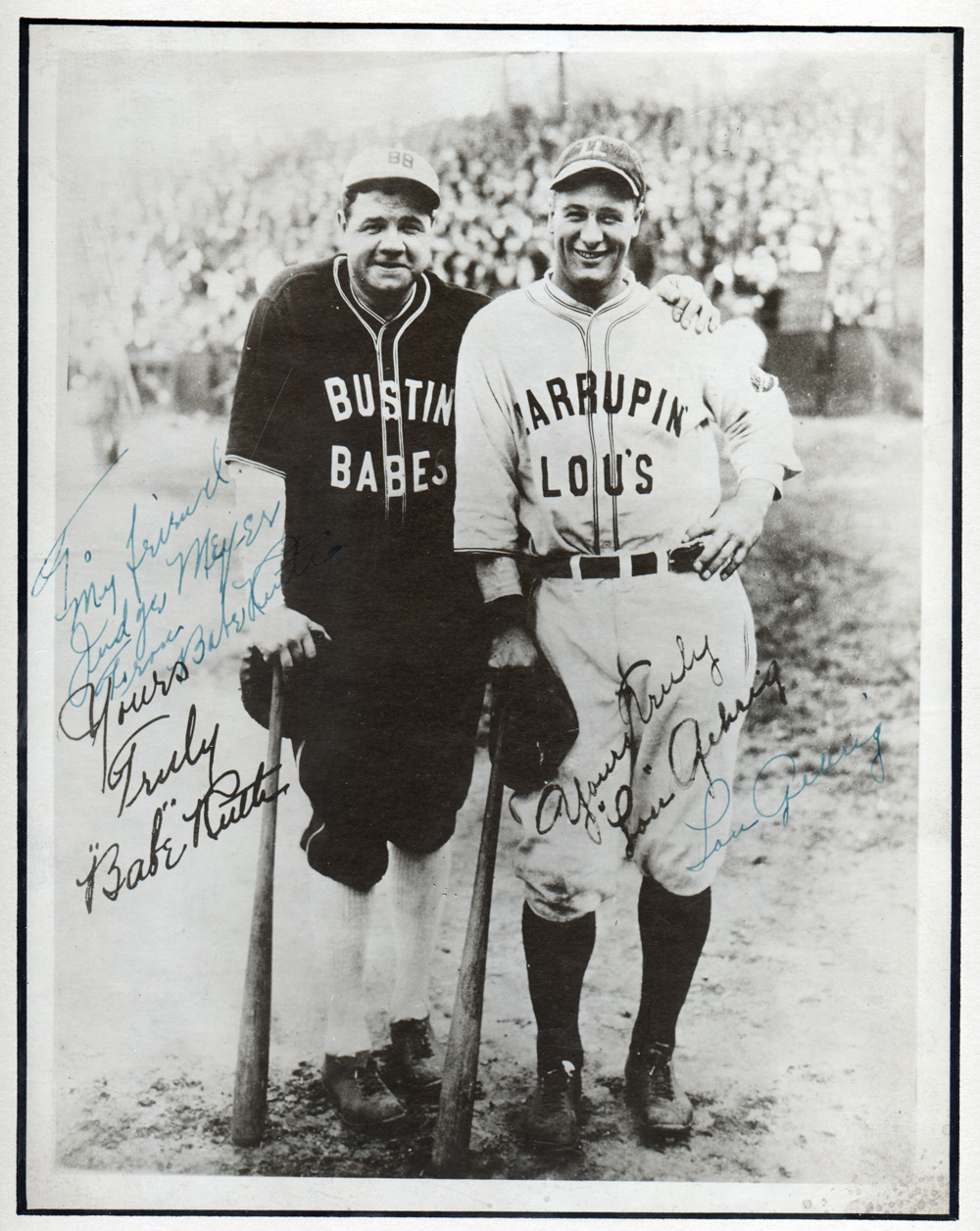 In an age when Giancarlo Stanton gets a 13-year, $325 million contract and Bryce Harper decides a 10-year agreement at $30 million per year isn’t enough, one has to wonder what teams would pay in today’s dollars to acquire the services of a Babe Ruth or Lou Gehrig. Would they be worth $40 million a year? Maybe $50 million? Long before the days of mega-sponsors and television revenues, baseball players (even the really good ones) didn’t make the kind of generational wealth that they do today. In fact, many took off-season jobs to supplement their income. In 1927, fresh off of a record-setting 60 home run season, Babe Ruth was paid an “audacious” sum of $70,000 per year, almost as much as the President of the United States at the time. But in today’s currency, that amounts to about a million dollars a year. Considering the league average in 2018 was just north of $4 million per year, the greatest player in baseball history at his peak was receiving the salary of a marginal major-leaguer in the present. That’s where “barnstorming” came in.
In an age when Giancarlo Stanton gets a 13-year, $325 million contract and Bryce Harper decides a 10-year agreement at $30 million per year isn’t enough, one has to wonder what teams would pay in today’s dollars to acquire the services of a Babe Ruth or Lou Gehrig. Would they be worth $40 million a year? Maybe $50 million? Long before the days of mega-sponsors and television revenues, baseball players (even the really good ones) didn’t make the kind of generational wealth that they do today. In fact, many took off-season jobs to supplement their income. In 1927, fresh off of a record-setting 60 home run season, Babe Ruth was paid an “audacious” sum of $70,000 per year, almost as much as the President of the United States at the time. But in today’s currency, that amounts to about a million dollars a year. Considering the league average in 2018 was just north of $4 million per year, the greatest player in baseball history at his peak was receiving the salary of a marginal major-leaguer in the present. That’s where “barnstorming” came in.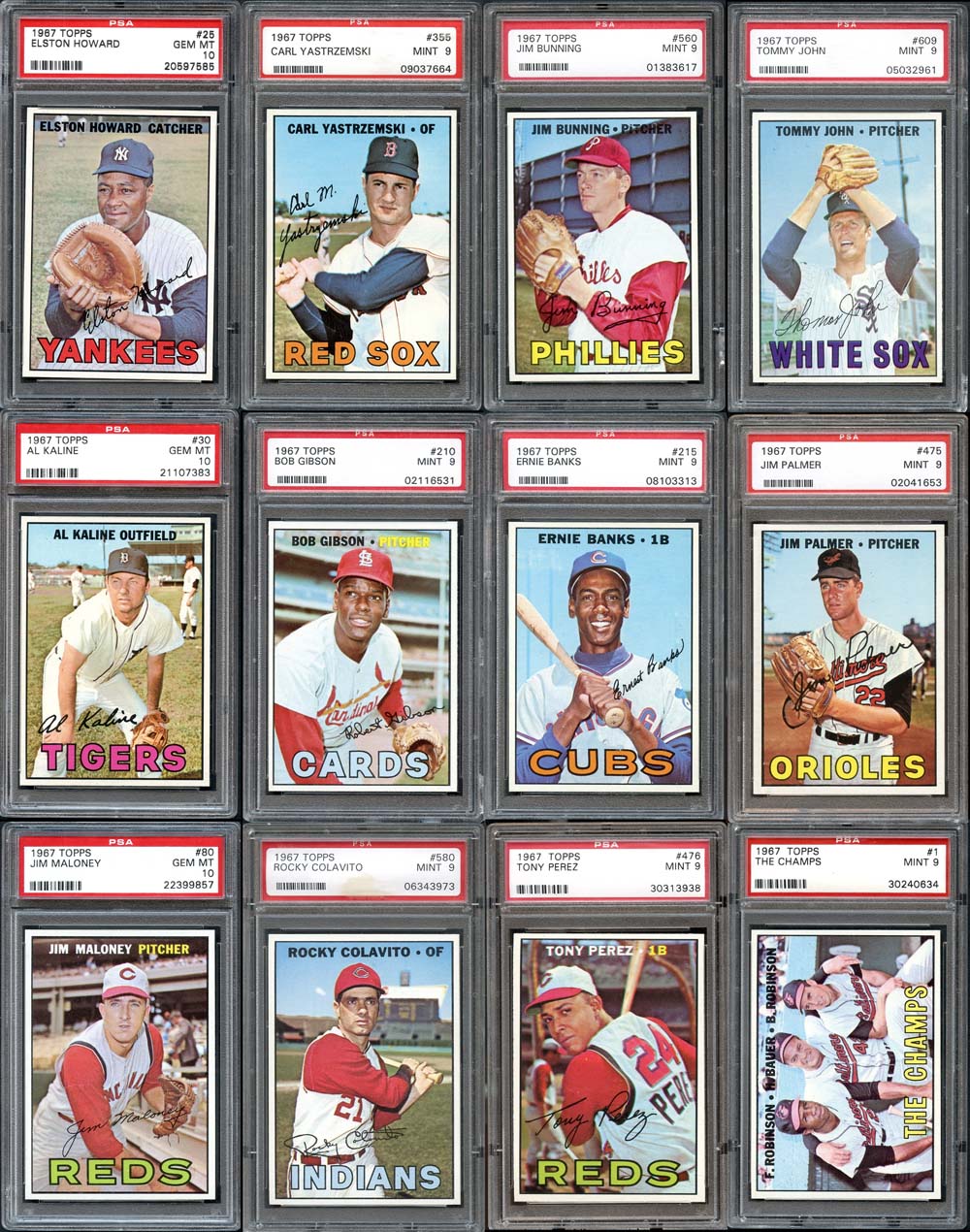
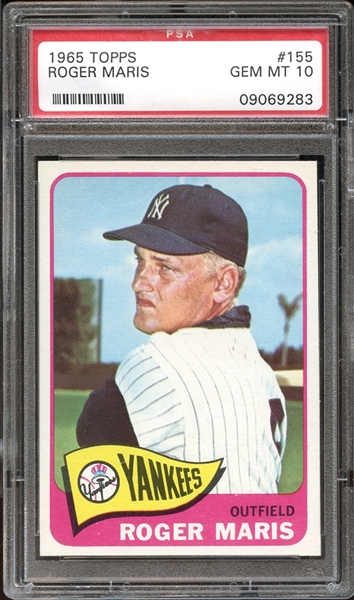
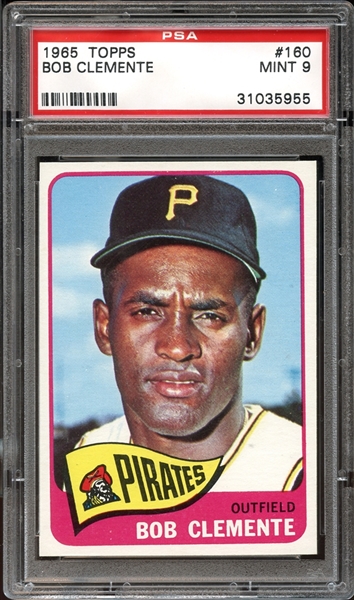
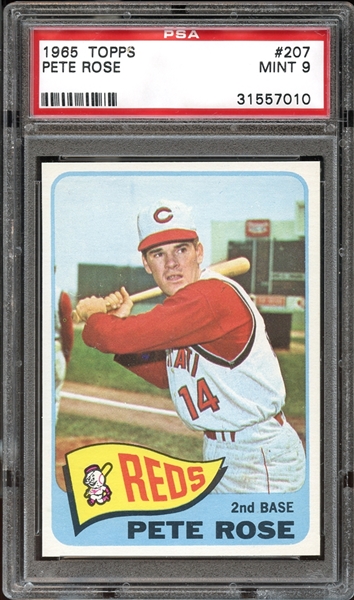
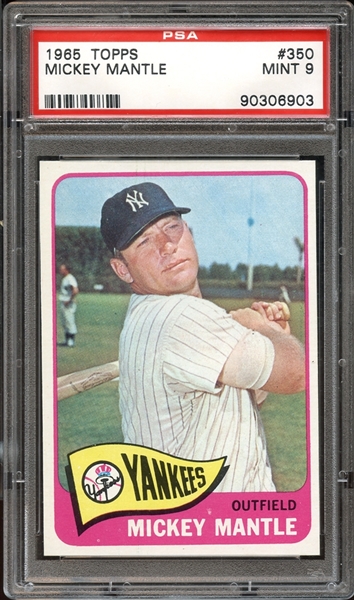
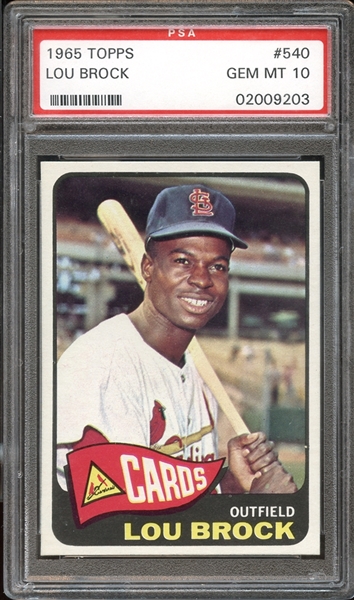
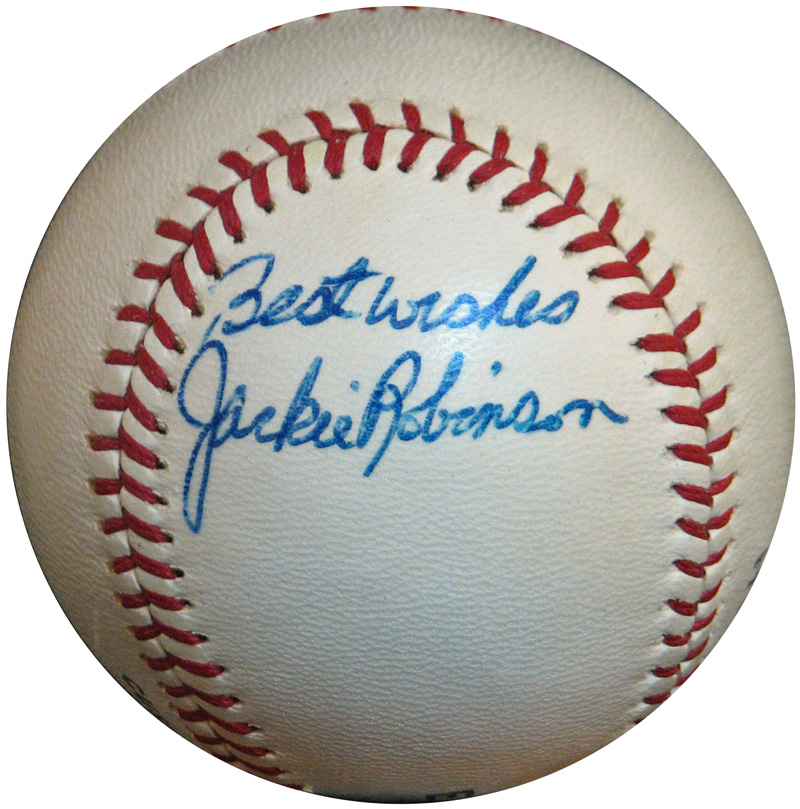
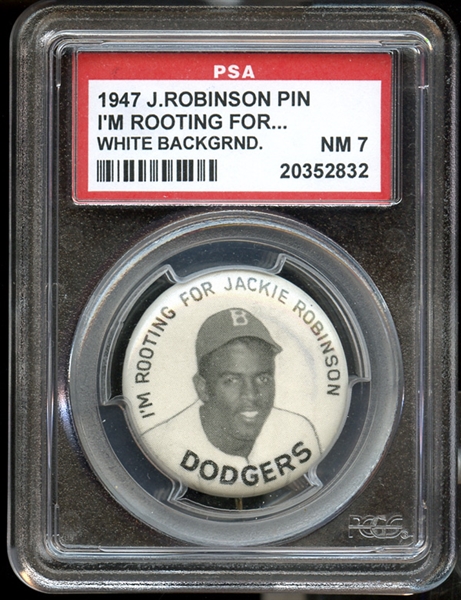
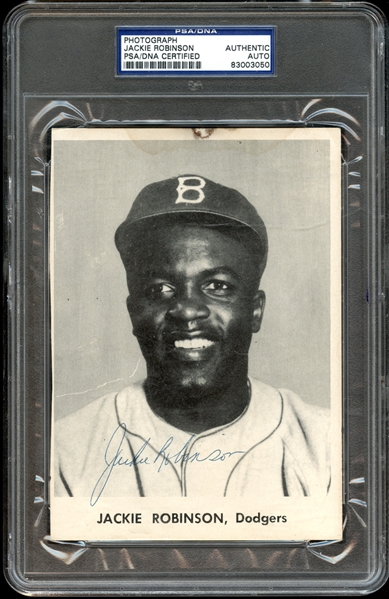 Starting his major league career at the advanced age of 28, Robinson played only ten seasons from 1947 – 1956, all of them for the Brooklyn Dodgers. During that time, the Dodgers played in six World Series and Robinson was selected to play in six All-Star games. His career marked the beginning of the “post long-ball” era that saw the strategy of raw power give way to a more balanced attack that included speed and superior base running. Robinson was one of only two players during his career to accumulate at least 125
Starting his major league career at the advanced age of 28, Robinson played only ten seasons from 1947 – 1956, all of them for the Brooklyn Dodgers. During that time, the Dodgers played in six World Series and Robinson was selected to play in six All-Star games. His career marked the beginning of the “post long-ball” era that saw the strategy of raw power give way to a more balanced attack that included speed and superior base running. Robinson was one of only two players during his career to accumulate at least 125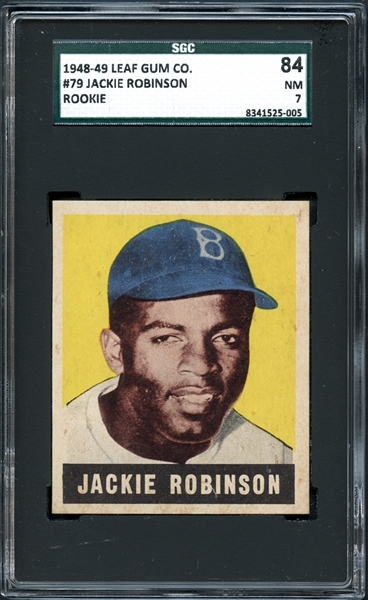
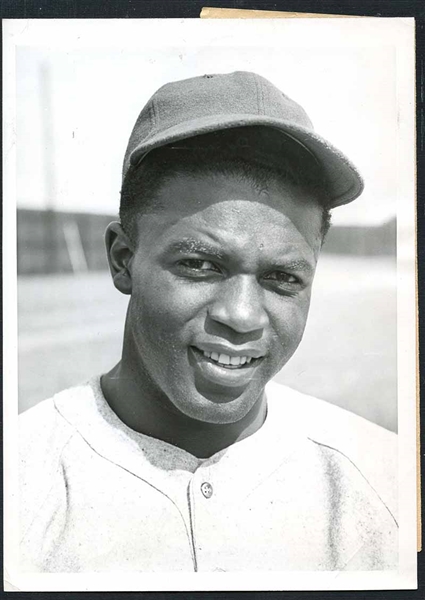
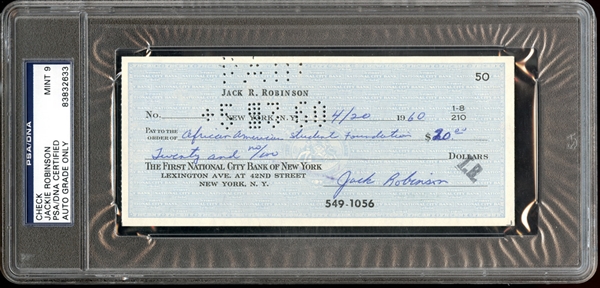
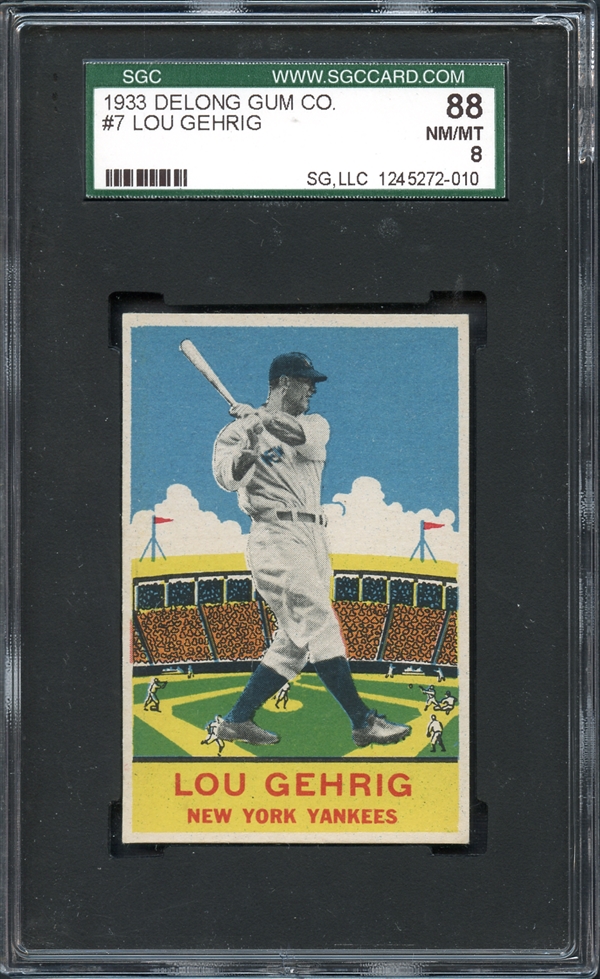 Harold DeLong had an advantage as a key executive in the development of the Goudey series prior to his departure, allowing him to create a clearly more aesthetic product than his former employer, but there were just too many obstacles standing in his way. Goudey, founded in 1919, was a well-established purveyor of chewing gum and had the financial might to secure the materials needed to produce the largest mainstream collection since the legendary T206 series. DeLong, on the other hand, was pioneering a poorly funded start-up that could only muster the ability to release a diminutive 24-card collection. Oh, but what a collection it was! While the brightly colored pigments, real life player depictions and ornate background artistry were a tremendous contrast from the straightforward and often monochrome format of the Goudey collection, there simply was no way that DeLong’s small series could compete with a Goudey set ten times the size that included a quartet of Babe Ruth cards. In addition, the DeLong cards didn’t have the nationwide distribution channel of the Goudey series, and if that wasn’t enough of a handicap, it was widely thought that Goudey’s bubble gum was just clearly superior. Even in the hometown Boston area, DeLong had to contend not only with Goudey but also had to compete with the regionally issued George C. Miller collection. All things considered, DeLong never really stood a chance of success.
Harold DeLong had an advantage as a key executive in the development of the Goudey series prior to his departure, allowing him to create a clearly more aesthetic product than his former employer, but there were just too many obstacles standing in his way. Goudey, founded in 1919, was a well-established purveyor of chewing gum and had the financial might to secure the materials needed to produce the largest mainstream collection since the legendary T206 series. DeLong, on the other hand, was pioneering a poorly funded start-up that could only muster the ability to release a diminutive 24-card collection. Oh, but what a collection it was! While the brightly colored pigments, real life player depictions and ornate background artistry were a tremendous contrast from the straightforward and often monochrome format of the Goudey collection, there simply was no way that DeLong’s small series could compete with a Goudey set ten times the size that included a quartet of Babe Ruth cards. In addition, the DeLong cards didn’t have the nationwide distribution channel of the Goudey series, and if that wasn’t enough of a handicap, it was widely thought that Goudey’s bubble gum was just clearly superior. Even in the hometown Boston area, DeLong had to contend not only with Goudey but also had to compete with the regionally issued George C. Miller collection. All things considered, DeLong never really stood a chance of success.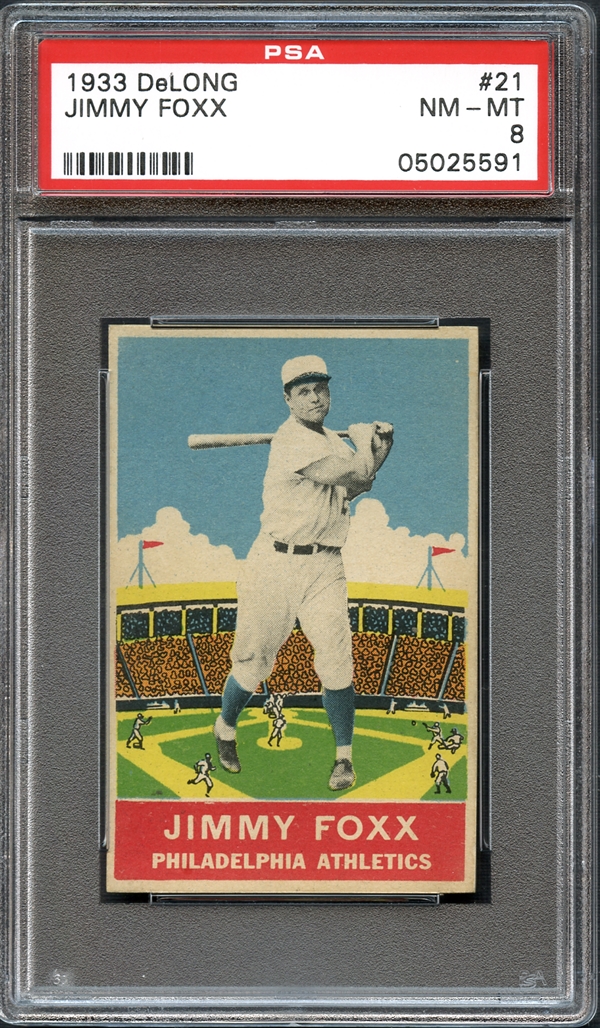 Although there is no Babe Ruth card in the DeLong set, the 24-card collection is jam-packed with star power, boasting 15 Hall of Famers and led by the issues of Yankees Hall of Famer Lou Gehrig and fellow Cooperstown resident Jimmie Foxx. In addition to their groundbreaking appearance, what makes the DeLong series so highly collectible to advanced hobbyists is the difficulty to build an elite assemblage. Nearly 3,000 cards from the entire 24-card collection have passed through the halls of PSA without a single GEM MINT specimen, only two graded MINT and just five subjects (McManus, Terry, Traynor, Gomez and Klein) making it into double-digits pops at the PSA 8 level. Ironically, some of the most difficult high-grade finds from the series are not Hall of Famers: Oscar Melillo, Riggs Stephenson and Lon Warneke. While the series is a challenge to build, there are presently 31 complete collections on the PSA Set Registry with just eight that have reached a level of 7.0 or higher.
Although there is no Babe Ruth card in the DeLong set, the 24-card collection is jam-packed with star power, boasting 15 Hall of Famers and led by the issues of Yankees Hall of Famer Lou Gehrig and fellow Cooperstown resident Jimmie Foxx. In addition to their groundbreaking appearance, what makes the DeLong series so highly collectible to advanced hobbyists is the difficulty to build an elite assemblage. Nearly 3,000 cards from the entire 24-card collection have passed through the halls of PSA without a single GEM MINT specimen, only two graded MINT and just five subjects (McManus, Terry, Traynor, Gomez and Klein) making it into double-digits pops at the PSA 8 level. Ironically, some of the most difficult high-grade finds from the series are not Hall of Famers: Oscar Melillo, Riggs Stephenson and Lon Warneke. While the series is a challenge to build, there are presently 31 complete collections on the PSA Set Registry with just eight that have reached a level of 7.0 or higher.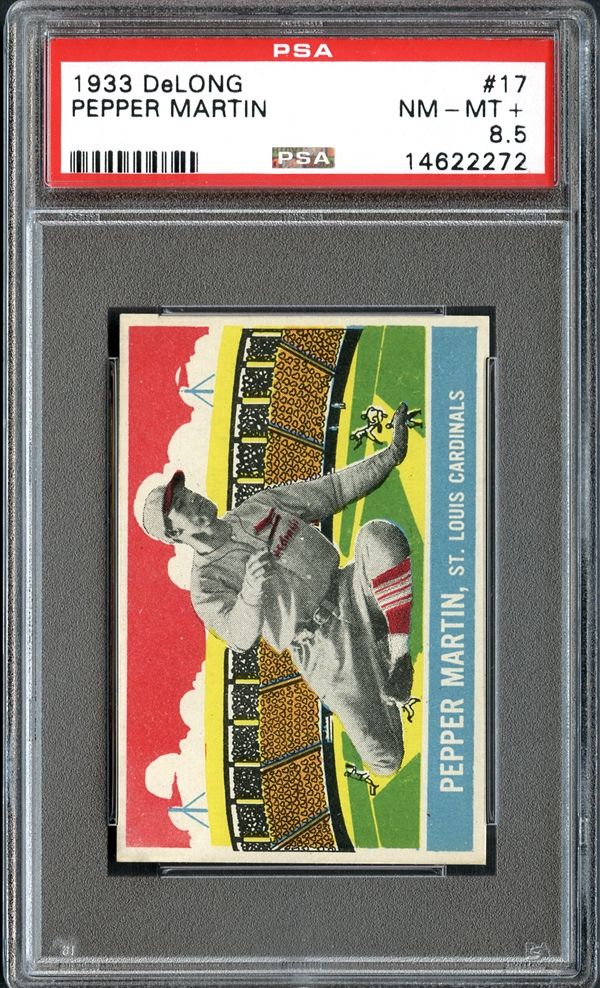 Featured in the Mile High Card Company September Auction is the second finest 1933 DeLong set ever assembled, boasting a set rating of approximately 8.83 with several PSA 8.5 cards that stand as the one and only examples at that grading tier with none graded higher. All but two of the cards in the collection have a grade of NM/MT or better. As MHCC has done in the past with world-ranked assemblages, this collection is being offered as a complete set as well as each card offered individually, with the final sale going to whichever total (the set versus the sum of the individual lots) is higher.
Featured in the Mile High Card Company September Auction is the second finest 1933 DeLong set ever assembled, boasting a set rating of approximately 8.83 with several PSA 8.5 cards that stand as the one and only examples at that grading tier with none graded higher. All but two of the cards in the collection have a grade of NM/MT or better. As MHCC has done in the past with world-ranked assemblages, this collection is being offered as a complete set as well as each card offered individually, with the final sale going to whichever total (the set versus the sum of the individual lots) is higher.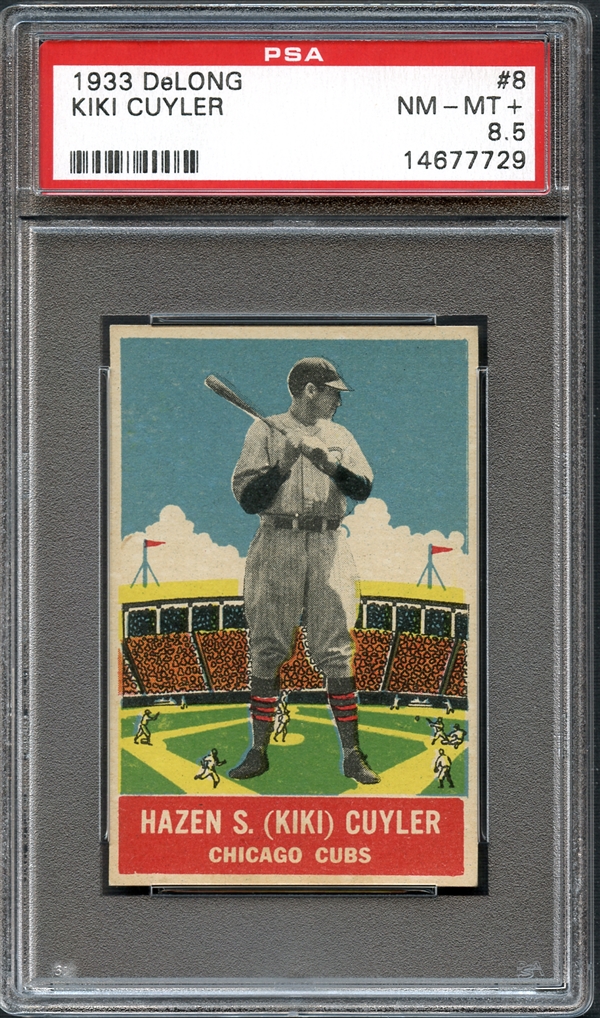
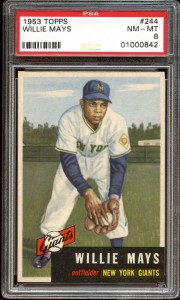
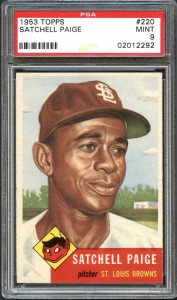
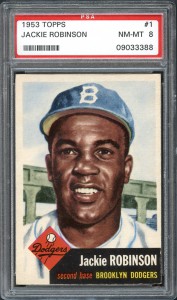
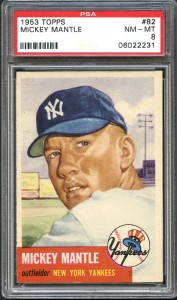
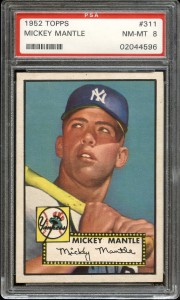
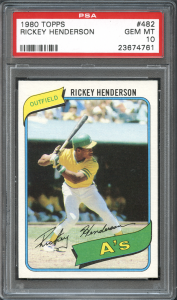
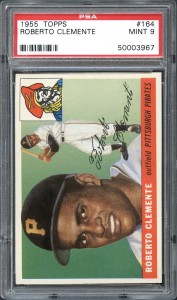
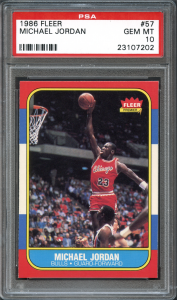
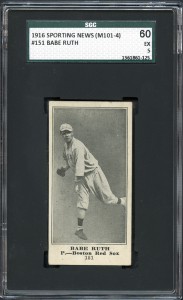 The most important rookie card ever produced!
The most important rookie card ever produced!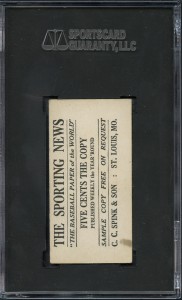 Offered is one of the most stunning, mid-grade M101-4 Sporting News Babe Ruth rookie cards in existence!
Offered is one of the most stunning, mid-grade M101-4 Sporting News Babe Ruth rookie cards in existence! Beginning with William Howard Taft throwing the ceremonial first pitch on Opening Day in 1910, America’s Commander In Chief and its national pastime have become an unshakable partnership. Eleven Presidents since Taft have marked the official opening of baseball season with varying results. In 1940, President Franklin Delano Roosevelt, a seasoned veteran at throwing the first pitch, provided a moment of comedy when his pitch sailed wildly off target and smashed the camera of Washington Post photographer Irving Schlossenberg. Ten years later, President Harry S. Truman wowed the stadium crowd by displaying his ambidextrous abilities and throwing two first pitches, one with each hand. In 1962, JFK threw the ceremonial pitch to open the new District of Columbia Stadium, renamed Robert F. Kennedy Stadium in 1969 after his brother’s assassination. With the exodus of the Washington Senators to Texas, President Richard Nixon traveled to his home state of California in 1973 to deliver the pitch at Anaheim Stadium, becoming the first President to open a new season outside the nation’s capital. In ’84, Ronald Reagan delivered a strike and then watched the game from the dugout, the first President ever to do so. And in 1993, President Clinton became the first to leave the security of the Secret Service and take the mound to throw his pitch.
Beginning with William Howard Taft throwing the ceremonial first pitch on Opening Day in 1910, America’s Commander In Chief and its national pastime have become an unshakable partnership. Eleven Presidents since Taft have marked the official opening of baseball season with varying results. In 1940, President Franklin Delano Roosevelt, a seasoned veteran at throwing the first pitch, provided a moment of comedy when his pitch sailed wildly off target and smashed the camera of Washington Post photographer Irving Schlossenberg. Ten years later, President Harry S. Truman wowed the stadium crowd by displaying his ambidextrous abilities and throwing two first pitches, one with each hand. In 1962, JFK threw the ceremonial pitch to open the new District of Columbia Stadium, renamed Robert F. Kennedy Stadium in 1969 after his brother’s assassination. With the exodus of the Washington Senators to Texas, President Richard Nixon traveled to his home state of California in 1973 to deliver the pitch at Anaheim Stadium, becoming the first President to open a new season outside the nation’s capital. In ’84, Ronald Reagan delivered a strike and then watched the game from the dugout, the first President ever to do so. And in 1993, President Clinton became the first to leave the security of the Secret Service and take the mound to throw his pitch.
 Opening Day has had its share of historic moments. In 1901, the Detroit Tigers opened the season by rallying from a 13-4 deficit to defeat the Milwaukee Brewers 14-13. In 1923, Yankee Stadium opened its doors with a 4-1 victory over the Red Sox behind a third-inning Babe Ruth homer, starting the legend of “The House That Ruth Built.” In 1940, Bob Feller opened the new season by tossing a no-hitter against the White Sox; he would lead the league in wins, ERA, complete games and strikeouts that year. Of course there’s 1947, when Jackie Robinson trotted to first base at Ebbets field and broke baseball’s long-standing color barrier. And in 1974, Hank Aaron stepped to the plate in Cincinnati and delivered a first-inning round tripper, his 714th career dinger, tying him with Babe Ruth for career home runs.
Opening Day has had its share of historic moments. In 1901, the Detroit Tigers opened the season by rallying from a 13-4 deficit to defeat the Milwaukee Brewers 14-13. In 1923, Yankee Stadium opened its doors with a 4-1 victory over the Red Sox behind a third-inning Babe Ruth homer, starting the legend of “The House That Ruth Built.” In 1940, Bob Feller opened the new season by tossing a no-hitter against the White Sox; he would lead the league in wins, ERA, complete games and strikeouts that year. Of course there’s 1947, when Jackie Robinson trotted to first base at Ebbets field and broke baseball’s long-standing color barrier. And in 1974, Hank Aaron stepped to the plate in Cincinnati and delivered a first-inning round tripper, his 714th career dinger, tying him with Babe Ruth for career home runs. While George Bell, Tuffy Rhodes, and Dmitri Young all share the title of smashing three home runs in the season opener, several notable ballplayers have a track record of excellence in the season’s premier contest. Ted Williams had a lifetime .449 batting average in fourteen opening contests with at least one hit in every game. Frank Robinson and Ken Griffey Jr. have hit eight Opening Day round-trippers with Willie Mays and Eddie Mathews right behind at seven. Jimmy Key holds a perfect 7-0 record on the mound in season openers with Greg Maddux at 6-0. But perhaps the best performer on Opening Day is the great Walter Johnson, who hurled nine shutouts in fourteen career starts.
While George Bell, Tuffy Rhodes, and Dmitri Young all share the title of smashing three home runs in the season opener, several notable ballplayers have a track record of excellence in the season’s premier contest. Ted Williams had a lifetime .449 batting average in fourteen opening contests with at least one hit in every game. Frank Robinson and Ken Griffey Jr. have hit eight Opening Day round-trippers with Willie Mays and Eddie Mathews right behind at seven. Jimmy Key holds a perfect 7-0 record on the mound in season openers with Greg Maddux at 6-0. But perhaps the best performer on Opening Day is the great Walter Johnson, who hurled nine shutouts in fourteen career starts.